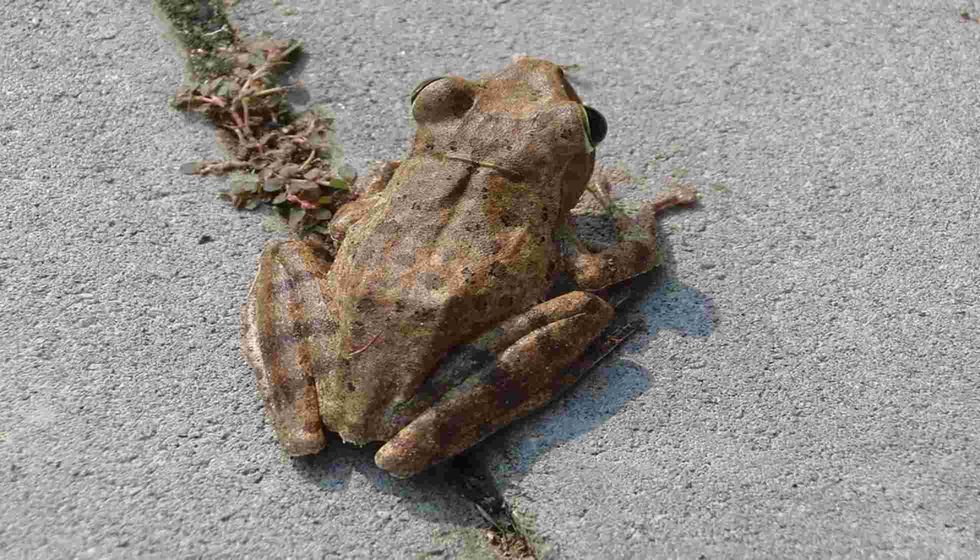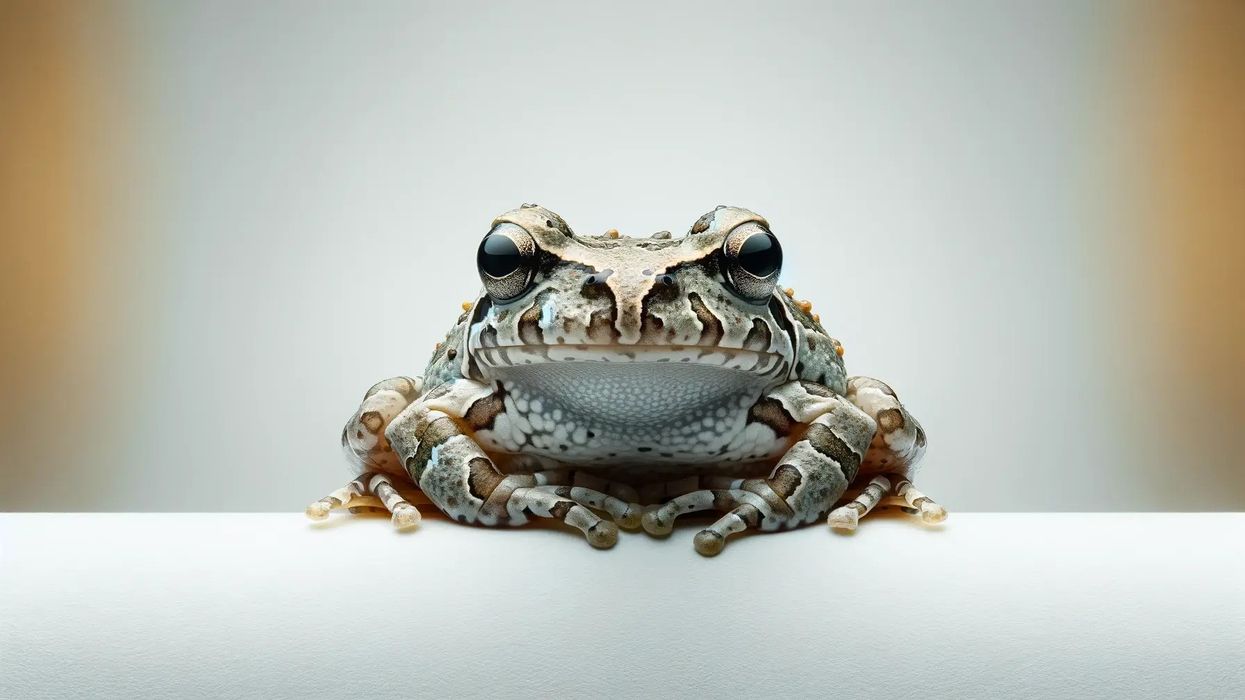Common tree frogs (Polypedates leucomystax) are endemic in all continents except Antarctica. Usually regarded as the most common frog of its species, they are found to live on trees in forests, or near lakes and ponds, or among moist ground cover.
They are available throughout their range but are most diverse in the tropics of the western hemisphere. The skin color is of variable shades of grey, black, yellow, green, brown, and the backs are striped.
The frogs reproduce by laying eggs that hatch and give birth to tadpoles.
It is also known as a four-lined tree frog. To know more facts about the range, conservation status, call, legs, description of four-lined tree frog, common tree frog care, colors of a common tree frog, golden tree frog, common brown tree frog, common tree frog size, most common tree frog, common tree frog identification, read this article.
For more relatable content, check out these pickerel frog facts and African bullfrog facts for kids.
Common Tree Frog Interesting Facts
What type of animal is a common tree frog?
Common tree frogs are a species of frog available all over the world, except in Antarctica. Some other species of frogs like goliath frog and poison frog,
What class of animal does a common tree frog belong to?
Tree frogs belong to the Amphibia class in the Animalia kingdom.
How many common tree frogs are there in the world?
No approximation is available regarding the total number of tree frogs in the world. However, there are over 800 species of tree frogs available worldwide.
Where does a common tree frog live?
Tree frogs (Polypedates leucomystax) are found all over the world, except Antarctica. They are available throughout their range but are most diverse in the tropics of the western hemisphere. More than 600 species alone can be found in Central and South America, while nearly 30 species are found in the United States.
What is a common tree frog's habitat?
Tree frogs are found in forests, near water bodies mainly. Most of the true tree frogs live on trees. Non-arboreal tree frogs are usually found in moist ground cover or near ponds and lakes.
Who do common tree frogs live with?
Most tree frogs, such as the Cuban tree frog, are solitary creatures and prefer to live alone. However, they can share a terrarium with tropical lizards, like anoles and other species of frogs that are of the same size as them.
How long does a common tree frog live?
Tree frogs have an average lifespan of 5-9 years. However, they tend to live longer when kept in captivity.
How do they reproduce?
Tree frogs are oviparous in nature, meaning they lay their eggs in water. The eggs hatch to form tadpoles.
What is their conservation status?
Tree frogs are not listed in the IUCN Red List. However, like all amphibians, they are at a high risk of extinction. The tree frogs' family breathe through their skin, which makes them particularly sensitive to environmental change. Some of the most common threats to these species include pollution, diseases like chytridiomycosis, climate change, and habitat destruction.
Common Tree Frog Fun Facts
What do common tree frogs look like?
Common tree frogs (Polypedates leucomystax) have striped, moderately slender, ovoid bodies that are slightly flattened above and have sharp, pointed tails. Males reach a length of 1.5–2.0 in (3.7–5.0 cm), while females have an average length of 0.22-0.30 in (5.7–7.5 mm). The upper part of the body has smooth skin.
The body color is somewhat variable, with various shades of yellow, gray, dark brown, reddish, or green. Ordinarily, the frogs are erratically mottled, usually with four stripes along the back.
The tip of the snout seldom reveals a distinct white spot with the eyes being on side of the head. The hind feet are webbed. The feet have clear, large cushions as usual with leaf frogs.
How cute are they?
Tree frogs are slimy creatures and are not cute at all. However, when they are tadpoles they can be quite cute.
How do they communicate?
Tree frogs (Polypedates leucomystax) usually communicate with specific vocalizations. All male frogs have staple advertisement calls with which they attract their mates. Each of the male species has its own call for the female frogs to listen and find potential mates from their own species. As is in all frog species, females are silent.
How big is a common tree frog?
These male frogs reach a length of 1.5–2.0 in (3.7–5.0 cm), while females have an average length of 0.22-0.30 in (5.7–7.5 mm). The white-lipped tree frog (Litoria infrafrenata) is the largest tree frog in the world.
It is found in Australia and Oceania and has a length of 4-5.5 in (10-14 cm). The smallest tree frogs measure less than 1 in (2.5 cm) in length.
How fast can a common tree frog move?
Tree frogs can move quite fast, leaping a foot forward with every jump.
How much does a common tree frog weigh?
Average tree frogs (Polypedates leucomystax) can weigh anywhere between 0.07-0.6 oz (2-17g).
What are the male and female names of the species?
There are no specific names for males and females of these species of tree frogs.
What would you call a baby common tree frog?
A baby tree frog is also called a tadpole.
What do they eat?
The diet of the common tree frog species includes small invertebrates and insects such as crickets, moths, ants, beetles, and flies. The tadpoles are mostly herbivores though.
How far can they jump?
Tree frogs can leap approximately 1 foot forward and get a few inches height in their jump.
Would they make a good pet?
Tree frogs are quite interesting pets. They are solitary creatures but should be handled with care. It is advisable not to touch them as they are very sensitive.
Did you know...
Tree frogs are not venomous unlike what is commonly believed. Instead, they will secrete a substance over their skin which they use to protect themselves against predators.
Why did my common tree frog burrow in the ground?
Tree frogs are a nocturnal species, meaning these amphibians are mostly active during the night. They hide in rotten logs, tree holes, under leaves, tree roots, and barks, when inactive. Hence, it is common for tree frogs to burrow in the earth.
How to take care of a common tree frog?
Tree frogs generally are not a suitable choice for owners looking for a pet that they can handle. Tree frogs possess very sensitive skins that get easily damaged if handled roughly.
Tree frogs are carnivorous and their diet consists of live insects which can be bought from your local reptile shop or online. The two biggest factors to ensure that your pet tree frog survives are to keep the levels of warmth and moisture present in the cage intact.
Here at Kidadl, we have carefully created lots of interesting family-friendly animal facts for everyone to discover! For more relatable content, check out these pool frog facts and blue poison dart frog facts pages.
You can even occupy yourself at home by coloring in one of our free printable common tree frog coloring pages.









